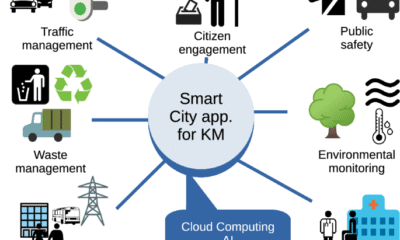Tools & Platforms
Researchers develop world’s first AI roadside technology to prevent animal–vehicle collisions

A team of researchers have developed and successfully tested a world-first roadside technology designed to prevent animal–vehicle collisions in regional Australia.
The code powering the AI technology will be made available for free worldwide on GitHub. This means researchers and conservationists will have the ability to develop animal-specific models globally.
With the code now publicly available, many more endangered species could be saved—including red pandas in Nepal, giant anteaters in Brazil, pangolins in Southeast Asia, and snow leopards in Central Asia, all of which face dangers when crossing roads that fragment their natural habitats.
The study was a joint effort between the University of Sydney, QUT, and the Department of Transport and Main Roads Queensland.
Researchers from the Australian Center for Robotics (University of Sydney) and the Center for Accident Research and Road Safety Queensland led the project. Over 12 months, they developed and tested a system called LAARMA—the Large Animal Activated Roadside Monitoring and Alert system.
LAARMA is a low-cost, AI-powered roadside unit. It uses sensors to detect animals near roads. When it spots one, it triggers nearby flashing Variable Message Signs (VMS) to warn drivers.
The field trial took place in Far North Queensland, where cassowary collisions are common. The system detected cassowaries with 97% accuracy and recorded over 287 sightings. The warning signs worked. When activated, they led to noticeable reductions in vehicle speed, lowering the risk of crashes.
‘The technology doesn’t just function—it evolves’
The LAARMA system includes a mix of pole-mounted sensors—RGB cameras, thermal imaging, and LiDAR. It also features self-training AI that learns and improves over time, even without labeled data. By the end of the trial, the system was correctly detecting animals 78.5% of the time within 100 meters.
Over five months, the team set up LAARMA poles in the wild cassowary hotspot of Kuranda.
The AI rapidly improved—going from catching just 4.2% of birds at first sight to 78.5% by the end of the trial. Meanwhile, driver speeds dropped by as much as 6.3 km/h when the signs flashed.
“The system teaches itself to get better,” Dr. Kunming Li from the University of Sydney’s Australian Center for Robotics said. “It’s self-supervised. Every time it spots a cassowary, it learns something new about it.”
Unlike older systems that need to be reprogrammed or trained by humans, LAARMA learns on its own. That means every time it sees a cassowary, it remembers how it looked—whether it was in the shadows, behind trees, or moving fast—and gets better at spotting them in the future.
“It doesn’t just look for a match,” Dr. Li explained. “It starts to understand what a cassowary usually looks like in different situations—like at dawn, in the rain, or half-hidden by bushes. That makes it smarter and more reliable the more it’s used.”
“This is a big step towards autonomous wildlife protection,” Dr. Li added. “LAARMA is far more adaptable and scalable than previous approaches. The more it’s used in the field, the more accurate it becomes. The technology doesn’t just function—it evolves.”
Behavioral science fused with AI
To go with the animal detection technology, researchers at QUT carefully designed and tested the warning messages shown on the roadside signs.
They used a well-known method from behavioral science to make sure the messages worked. The team tested different messages with focus groups, surveyed over 550 drivers across Australia, and ran driving simulator trials to see which messages were most effective in getting people to slow down.
Once a cassowary is detected, a specially designed digital sign lights up with a real-time warning, alerting drivers to slow down and keep their eyes peeled.
Unlike permanent yellow signs drivers might ignore on first glance, LAARMA only lights up when a cassowary is actually there—giving it real cut-through, according to researchers.
The final field trial demonstrated vehicle speeds reduced by up to 6.3 km/h in the event zone when the message was active, compared to baseline conditions.
This change in driver behavior is significant. Speed reduction, even by a few kilometers per hour, can substantially improve reaction times, braking distances, and outcomes in the event of a collision.
“Beyond the technological success, we’re particularly encouraged by the behavioral data, which shows that real-time, context-specific warnings do change how people drive,” Professor Ioni Lewis, project co-lead from QUT said. “That’s vital when seconds can be the difference between a near-miss and a fatal collision.”
Professor Lewis also emphasized the dual benefit of the system—protecting both endangered animals and road users. “Cassowaries are endangered. But they’re also big. Hitting one at 100 km/h could be like driving into a fridge. This is about saving lives—human and feathered,” she said.
A staggering 174 cassowaries have been killed by vehicles since 1996, according to the Department of Transport and Main Roads (TMR). Experts fear the true number is much higher, with many birds never reported and drivers unaware of the damage they’ve caused.
“Cassowaries on or near roads is part of life in Far North Queensland,” Ross Hodgman, TMR’s Regional Director North Queensland, said.
“We are committed to protecting this keystone species, not just for the important role they plan in the health of the Wet Tropics Rainforest, but to reduce crashes from either a direct hit or a driver swerving to avoid a bird.
“The outcomes of this research are very promising. To have a low-cost system that can be deployed at specific locations where there is a history of vehicle-animal collisions and be able to improve the awareness and advanced warning to drivers would provide a road safety improvement.”
Great example of Australian innovation
iMOVE CRC Managing Director Ian Christensen said, “This project is a great example of applied innovation. It exemplifies the power of combining cutting-edge sensing and AI technology with behavioral science to deliver practical solutions for real-world challenges.”
Christensen said making the LAARMA system open source via GitHub significantly expands its global potential. “By making the system open source, the team has made it easier for governments and conservation groups worldwide to adapt the technology to their own wildlife and road safety needs.”
The technology is already capable of being trained to identify multiple species.
More information:
Study: Large Australian animals and cars: Safety for all
Citation:
Researchers develop world’s first AI roadside technology to prevent animal–vehicle collisions (2025, August 6)
retrieved 6 August 2025
from https://techxplore.com/news/2025-08-world-ai-roadside-technology-animalvehicle.html
This document is subject to copyright. Apart from any fair dealing for the purpose of private study or research, no
part may be reproduced without the written permission. The content is provided for information purposes only.
Tools & Platforms
Microsoft researchers develop new tech for video AI agents – Computerworld

Microsoft researchers are developing technologies for a new class of video AI agents to explore three-dimensional spaces before making decisions.
The technology framework, called MindJourney, uses a range of AI technologies to understand and analyze 3D spaces, reason about the surroundings, and predict movement, the researchers wrote in a blog entry late last month.
MindJourney includes video-generation systems, vision language models (VLMs), and reasoning techniques that can predict surroundings, patterns, and movement. These technologies are packaged around “world models” that simulate real-world surroundings.
Tools & Platforms
Tech Entrepreneur Buys .AI Domain for $700K in AI Boom

In the bustling world of artificial intelligence startups, domain names have become more than mere web addresses—they’re status symbols and strategic assets. Dharmesh Shah, the co-founder of HubSpot and a prominent figure in tech entrepreneurship, recently shelled out $700,000 to secure a coveted .ai domain from the Caribbean island nation of Anguilla. This transaction, highlighted in a report by Business Insider, underscores the explosive demand for .ai suffixes amid the global AI frenzy, turning what was once an obscure country-code top-level domain into a multimillion-dollar revenue stream for a tiny territory.
Shah’s purchase isn’t an isolated case; it’s part of a broader trend where AI companies are vying for these domains to signal their focus on cutting-edge technology. Anguilla, with a population of just 15,000 and known more for its pristine beaches than its digital prowess, was assigned the .ai domain in the late 1980s by the Internet Assigned Numbers Authority. For decades, it languished in relative obscurity until the AI boom ignited interest, as companies like Stability.ai and Elon Musk’s x.ai snapped up addresses to align with the burgeoning field.
The Windfall from Digital Real Estate
The financial impact on Anguilla has been staggering. In 2024 alone, the island generated $39 million from .ai domain registrations and sales, representing nearly a quarter of its total government revenue, according to details shared in WebProNews. This influx has funded critical infrastructure projects, including hurricane-resilient buildings and improved public services, transforming what could have been a modest tourism-dependent economy into one buoyed by tech-driven windfalls.
High-profile deals like Shah’s highlight the premium pricing. While standard .ai registrations cost around $100 to $200 annually through registrars, premium or short domains command exorbitant sums in auctions or direct negotiations. The New York Times reported in a 2024 article that Anguilla earned $32 million the previous year from these domains, amounting to over 10% of its GDP, a figure that has only grown as AI investments surge globally.
Evolution of an Unlikely Tech Hub
The origins of this phenomenon trace back to the early days of the internet, when country codes were distributed without much foresight into future tech trends. As Fortune noted in 2023, early adopters like Character.ai recognized the branding potential, leading to a registration spike that could reach $30 million that year. Anguilla’s government, through its domain registry managed by a small team, has capitalized on this by streamlining sales and partnering with international brokers.
Yet, not everyone is optimistic about sustained growth. Shah himself, in comments to Business Insider, suggested that interest in .ai domains might taper off as the AI hype normalizes, comparing it to past tech bubbles. Still, for now, the domain has drawn interest from major players, with the BBC reporting in a recent piece that Anguilla’s .ai sales are funding everything from education to disaster preparedness, providing a buffer against economic vulnerabilities.
Broader Implications for Small Economies
This digital gold rush raises questions about equity in the global tech economy. Small nations like Anguilla, often overlooked in international trade, are finding innovative ways to leverage intangible assets. As detailed in The New York Times, the revenue stream has empowered local officials to invest in long-term resilience, such as upgrading power grids and water systems battered by climate events.
Industry insiders note that while .ai’s appeal stems from its brevity and relevance, competition from generic domains like .io or .tech could dilute its exclusivity. Nonetheless, Anguilla’s story illustrates how serendipitous assignments from the internet’s foundational era can yield outsized benefits today. For tech founders like Shah, securing a .ai domain isn’t just about branding—it’s a bet on AI’s enduring role in business innovation.
Sustaining the Momentum Amid Uncertainties
Looking ahead, Anguilla’s domain authority is exploring ways to maintain this revenue, including potential expansions into related digital services. Reports from BBC emphasize the island’s strategic positioning, with officials viewing .ai as a “gift from the digital gods” that has already amassed over $100 million cumulatively. Yet, as global AI regulations tighten and market saturation sets in, the challenge will be diversifying beyond this single asset.
For industry observers, Anguilla’s ascent serves as a case study in adaptive economics. Tech entrepreneurs continue to eye these domains for their cachet, but the real winners are the island’s residents, who benefit from an unexpected tech bonanza without ever coding a line. As Shah’s hefty payment demonstrates, in the AI era, even the smallest players can command big prices on the world stage.
Tools & Platforms
Who Powers The AI Revolution—Tech Giants, Utilities Or Both?

INDIA – 2021/01/27: In this photo illustration, the logo of Amazon Alexa is seen displayed on a mobile phone screen with The AI (artificial intelligence) revolution written in the background. (Photo Illustration by Idrees Abbas/SOPA Images/LightRocket via Getty Images)
SOPA Images/LightRocket via Getty Images
Artificial intelligence may run on silicon chips, but its real fuel is electricity. After two decades of steady demand, AI and data centers are causing electricity consumption to soar, which will require utilities and tech giants to collaborate or confront each other. Either way, the aim is for the country to quickly upgrade its network to meet this AI-driven energy surge.
Companies like Meta, Oracle, and OpenAI are building large campuses that require reliable, continuous power. This expansion is testing the capacity of a grid designed for a slower digital economy and prompting utilities, regulators, and tech firms to reconsider their roles, partnerships, and investments.
“Utilities know how to capitalize the cost of building a transformer like the back of their hand, but can’t capitalize a cloud subscription,” Elizabeth Cook of the Association of Edison Illuminating Companies told the audience during a podcast in which we appeared together. That bias toward physical assets has historically limited investment in operations, data analytics, or predictive tools.
Utilities have traditionally been low-risk, capital-heavy institutions. They invest in tangible infrastructure —poles, wires, substations—where costs can be depreciated and returns are assured. The utility industry states that its members often choose to be the first to come in second, implying they let more agile companies lead.
Tech giants can move quickly on high-risk, high-reward projects. Kim Getgen, founder of InnovationForce that hosted the podcast, notes that one hyperscaler can outspend the entire energy sector many times over—by some estimates, as much as fortyfold.
AI mega-data centers like Stargate, backed by Oracle, SoftBank, and OpenAI, are projected to generate $30 billion in annual revenue by 2028. These firms can build data centers in 12–18 months, while new power plants and transmission lines take at least five years to construct and connect. Why’s that?
Utilities make money by persuading commissions to approve capital spending, but operational investments—like grid analytics—generate lower returns. Tech companies, on the other hand, operate in a free market, giving them more flexibility to quickly allocate capital to meet fast-growing demand.
AI’s Soaring Power Demand
EVERGLADES, FLORIDA – SEPTEMBER 28: In an aerial view, electric power lines are seen attached to the transmission tower along the power grid on September 28, 2023 in the Everglades, Florida. The Federal government announced the distribution of Grid Resilience Formula Grants. The grants will help modernize the electric grid to reduce the impacts of climate-driven extreme weather and natural disasters while also ensuring the reliability of the power sector. (Photo by Joe Raedle/Getty Images)
Getty Images
According to the International Energy Agency, data center electricity demand worldwide will increase by 130% by 2030. The Department of Energy’s Lawrence Berkeley National Laboratory stated that data centers used about 4.4% of total U.S. electricity in 2023 and, depending on the growth of the rest of the economy, are projected to use between 6.7% and 12% of total U.S. electricity by 2028. It cautions that this depends heavily on AI adoption rates and efficiency gains.
The U.S. faces an unprecedented challenge in expanding its grid. Jeff Weiss, executive chairman of Distributed Sun, explained during a virtual press event hosted by the United States Energy Association: “We need to triple the grid. Everything we do today takes 10 years. We need to figure out how to do it in two.” In practice, that means tripling capacity—not literally rebuilding three new grids. One-third of that new capacity will be needed just to support data centers.
Existing generation, transmission, and workforce limits create bottlenecks. Supply chains for turbines, transformers, and other essential parts are insufficient for quick expansion. Regulatory permitting and interconnection procedures, designed for slower growth, cause further delays. High-powered transmission lines, which span multiple states, are extremely difficult to construct.
Despite having speed and capital advantages, tech giants cannot simply replace utilities. They must follow the same permitting, siting, and interconnection rules. So, it doesn’t matter if you are Google or the hometown utility. Meeting with stakeholders and complying with regulators is part of the process.
“You have to deal with the same federal laws, the same citing, the same public support, and the same supply chain,” says Tom Falcone, president of the Large Public Power Council, during the USEA event. “We deal with these issues in our social construct, in the laws and regulations that we have, and we all have to comply with them.”
However, the problem persists: data centers eager to run advanced AI models urgently need power. Utilities, limited by permitting timelines, supply chain issues, and workforce shortages, rarely meet that urgency. Derek Bentley, partner at Solomon Partners, highlighted the gap at the press event: “You can build a data center in 12 to 18 months. But a new power plant takes five years, plus years more to connect.”
Hybrid Solutions and Partnerships
ILLUSTRATION – 10 April 2025, Mecklenburg-Western Pomerania, Schwerin: The apps of various US tech companies, Google, Facebook, WhatsApp, Amazon and X, can be seen on the display of a smartphone. Photo: Jens Büttner/dpa (Photo by Jens Büttner/picture alliance via Getty Images)
dpa/picture alliance via Getty Images
This isn’t just inconvenient; it’s a fundamental mismatch between the 21st-century digital economy and a 20th-century grid. Progressive utilities are, therefore, working with data centers to develop hybrid solutions.
Indeed, some data centers are colocating with natural gas or nuclear facilities, sometimes combined with renewables and battery storage to enhance scale and reliability. These behind-the-meter setups—where power is generated on-site rather than solely from the grid—are becoming more common. These partnerships enable data centers to access power quickly while maintaining grid stability.
That relieves the burden on the central network, which lowers the risk of blackouts and congestion. Still, for those data centers connected to the main grid—in front of the meter—it results in higher revenues for utilities.
“Hyperscalers are more agile than many utilities, and they are more entrepreneurial and have the capital,” says Clinton Vince, head of the U.S. energy practice at the Denton law firm, during the USEA event. “I do think utilities have been working very well with hyperscalers, although the slower utilities will be disadvantaged tremendously.”
He highlights Meta and Entergy, which are partnering in Louisiana to build major infrastructure supporting Meta’s largest and newest data center, called Hyperion. It will be powered by both fossil fuels and renewable energy.
However, the main criticism is that the regulatory system encourages stagnation. Bud Albright, senior adviser at the National AI Association, pointed out during the press event that “The regulatory format is inadequate today to do the kind of build-out that we need, whether it’s behind the meter or in front of the meter.”
Beyond formal oversight, he adds that public opinion also plays a role. Communities wary of new data centers and transmission lines must understand the broader economic and technological benefits of these projects, from jobs to national competitiveness. Utilities and tech companies must prioritize education and outreach to demonstrate the benefits of their services.
Regulation and Public Perception
Rate design is also under review. Pacific Gas & Electric, for example, requires data centers to pay initial interconnection costs and recover them later as the facility earns revenue. This method ensures costs are shared fairly and stops residential customers from subsidizing commercial loads.
“Affordability is top of mind for us,” says Karen Omelas, director of large load program management for Pacific Gas & Electric. “But we see data centers as beneficial load.”
The energy mix is shifting. Solar and battery storage are expanding rapidly. In fact, storage is becoming a crucial tool to meet peak demand, helping utilities and hyperscalers manage load efficiently. Still, reliable, dispatchable power remains essential. Natural gas fulfills much of this need, while coal is dirtier, expensive, and increasingly irrelevant for electricity production.
All of this highlights a bigger truth: the ongoing transformation is a once-in-a-lifetime event. It’s not about who has the largest balance sheet or who is the most nimble. It’s about collaboration at scale. Utilities need to adopt new tools, rethink their operational models, and partner with the very tech companies they might have once seen as rivals. Meanwhile, tech firms must accept that building computers is one thing; powering them responsibly, reliably, and safely for the masses is another.
For policymakers, the challenge remains just as urgent. Innovation in regulation, faster permitting processes, and public education are essential to prevent congestion that could impede the digital economy. Without action, the infrastructure supporting AI—and the industries it drives—are at risk. And it won’t be because of a lack of creativity or ambition, but because of slow, outdated rules.
The AI revolution isn’t just about chips or advances in machine learning. It’s about wires and power plants. It’s also about the invisible links connecting millions of servers to millions of homes. AI’s ultimate limitation is less about computer intelligence and much more about how fast the grid can expand.
-

 Business4 days ago
Business4 days agoThe Guardian view on Trump and the Fed: independence is no substitute for accountability | Editorial
-
Tools & Platforms3 weeks ago
Building Trust in Military AI Starts with Opening the Black Box – War on the Rocks
-

 Ethics & Policy1 month ago
Ethics & Policy1 month agoSDAIA Supports Saudi Arabia’s Leadership in Shaping Global AI Ethics, Policy, and Research – وكالة الأنباء السعودية
-

 Events & Conferences3 months ago
Events & Conferences3 months agoJourney to 1000 models: Scaling Instagram’s recommendation system
-

 Jobs & Careers2 months ago
Jobs & Careers2 months agoMumbai-based Perplexity Alternative Has 60k+ Users Without Funding
-

 Education2 months ago
Education2 months agoVEX Robotics launches AI-powered classroom robotics system
-

 Funding & Business2 months ago
Funding & Business2 months agoKayak and Expedia race to build AI travel agents that turn social posts into itineraries
-

 Podcasts & Talks2 months ago
Podcasts & Talks2 months agoHappy 4th of July! 🎆 Made with Veo 3 in Gemini
-

 Education2 months ago
Education2 months agoAERDF highlights the latest PreK-12 discoveries and inventions
-

 Podcasts & Talks2 months ago
Podcasts & Talks2 months agoOpenAI 🤝 @teamganassi



















